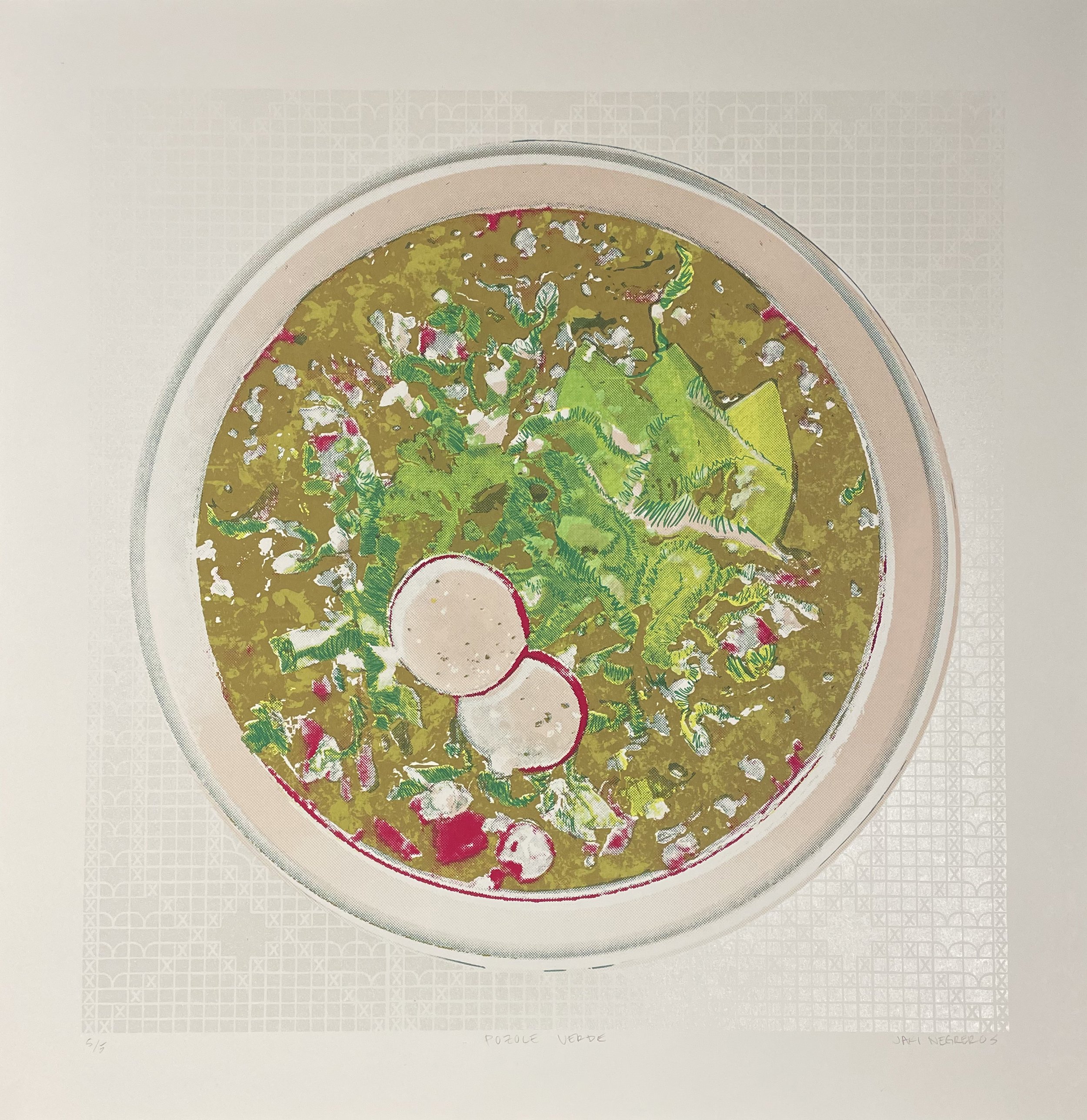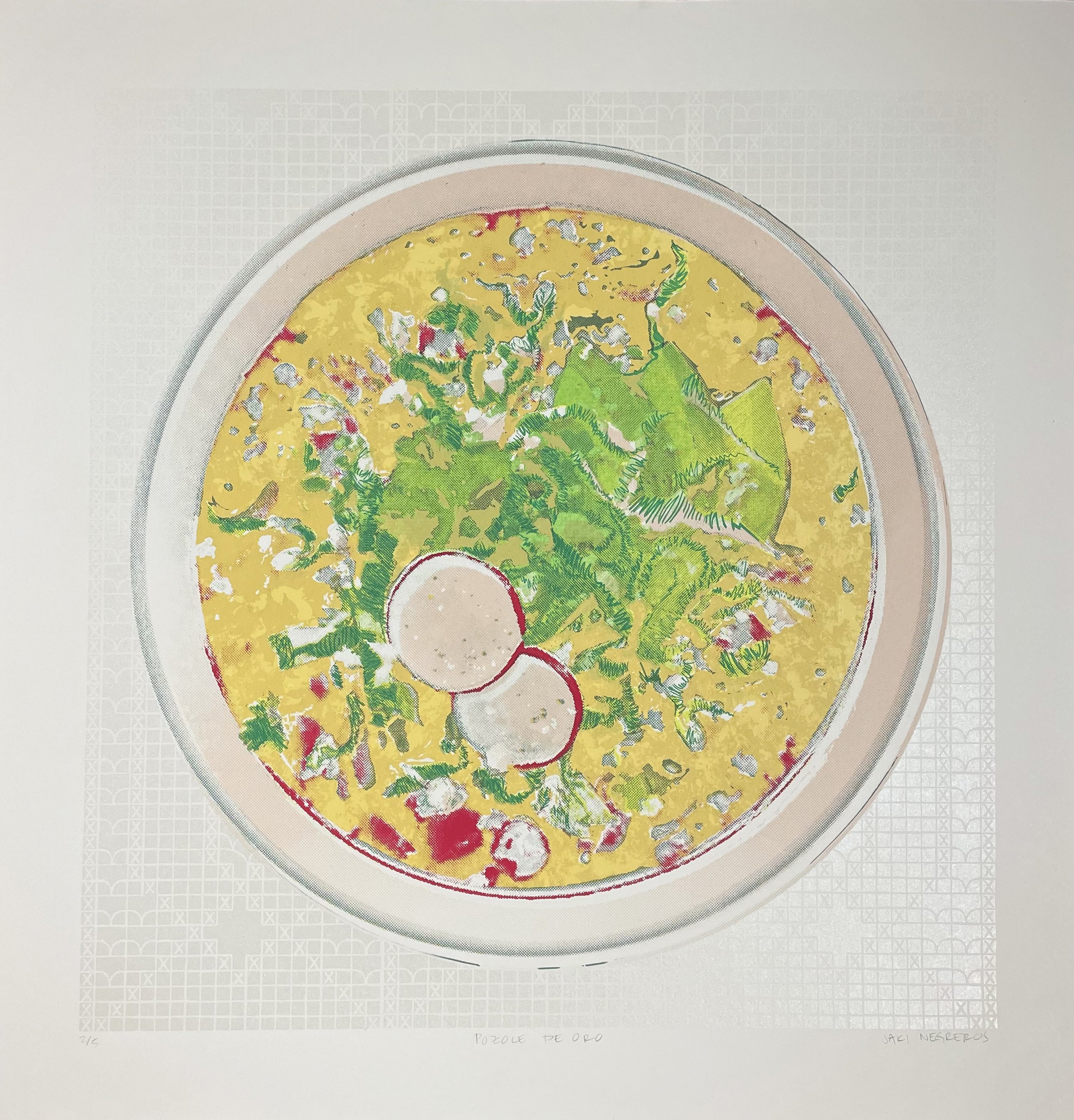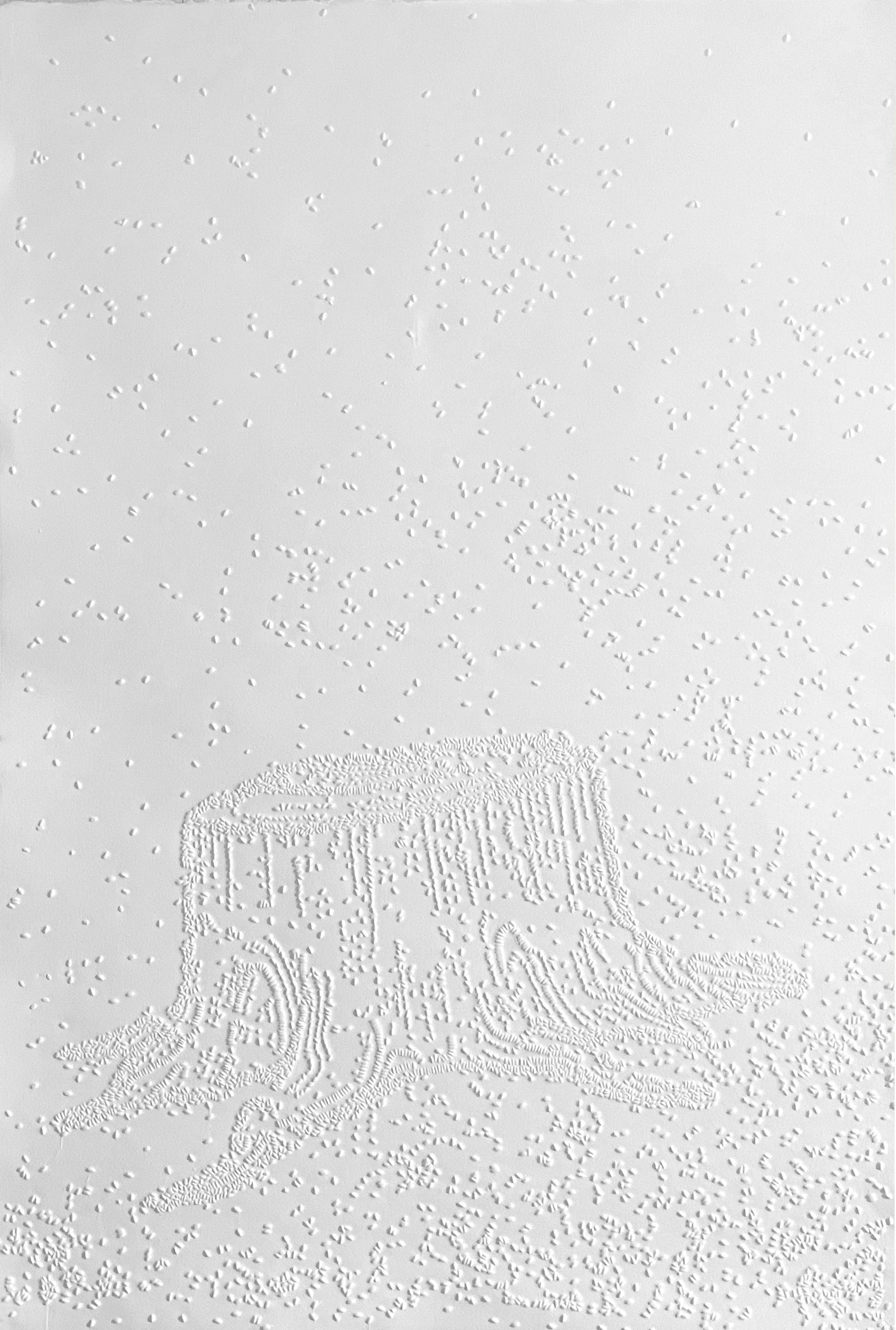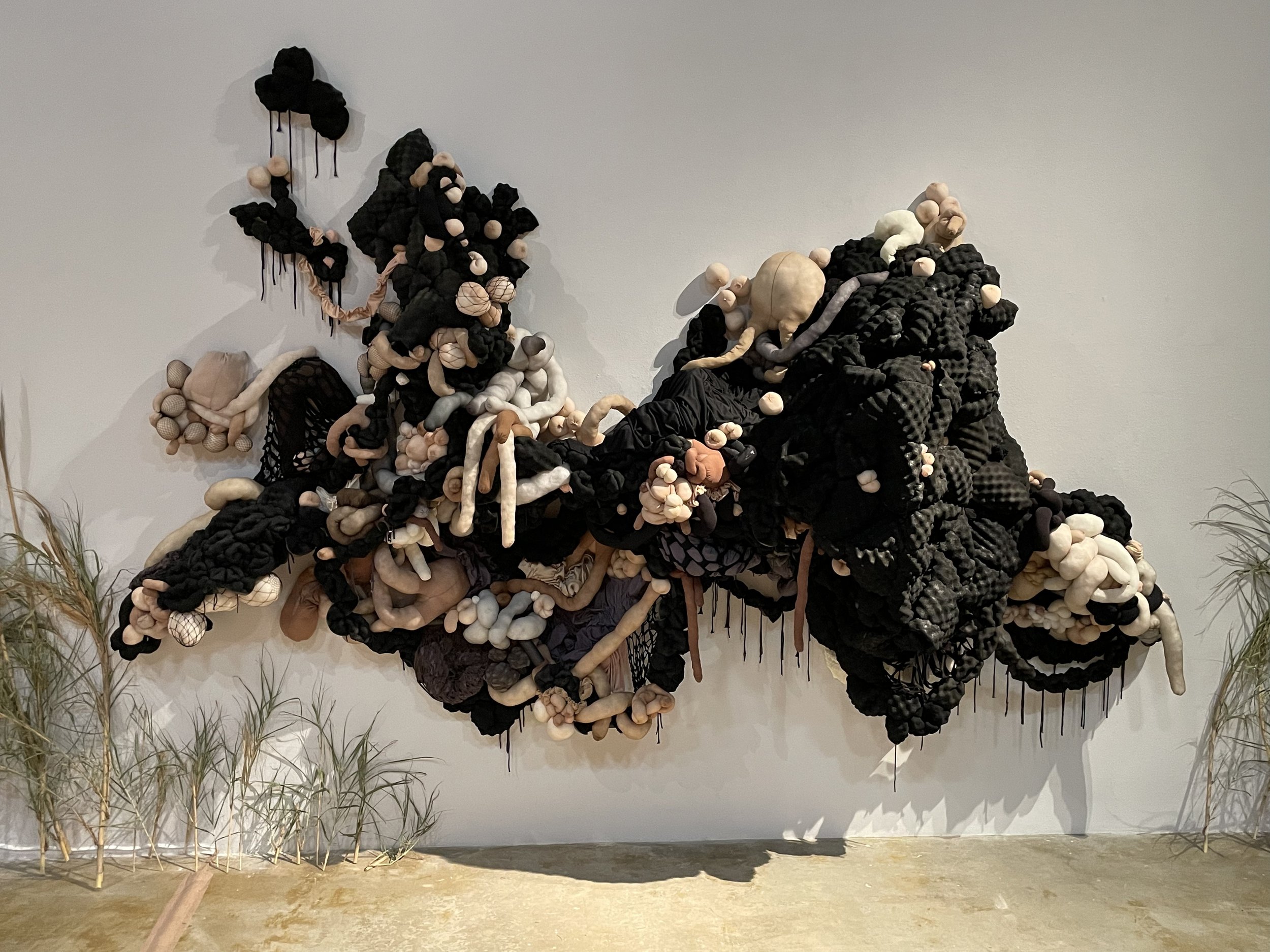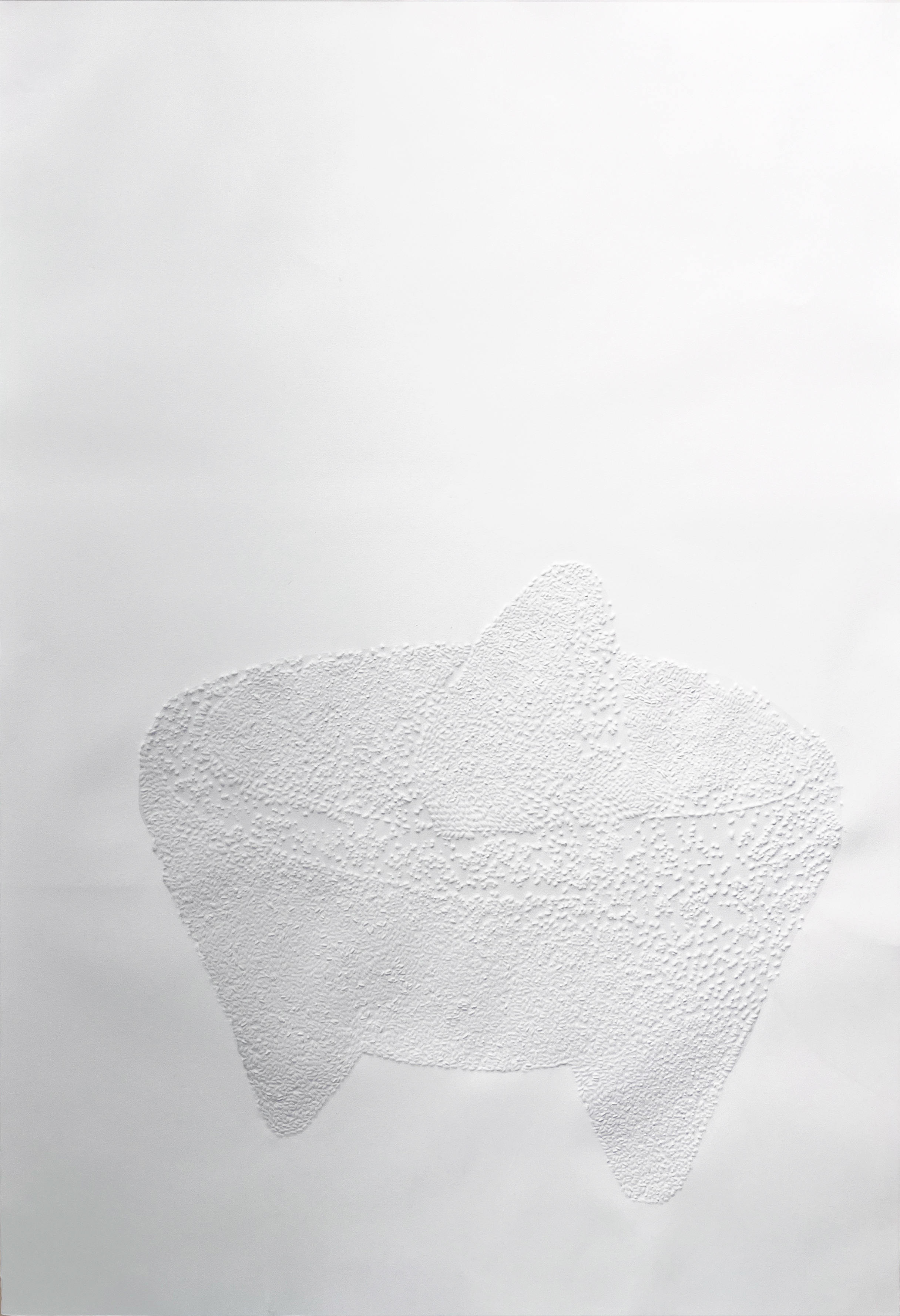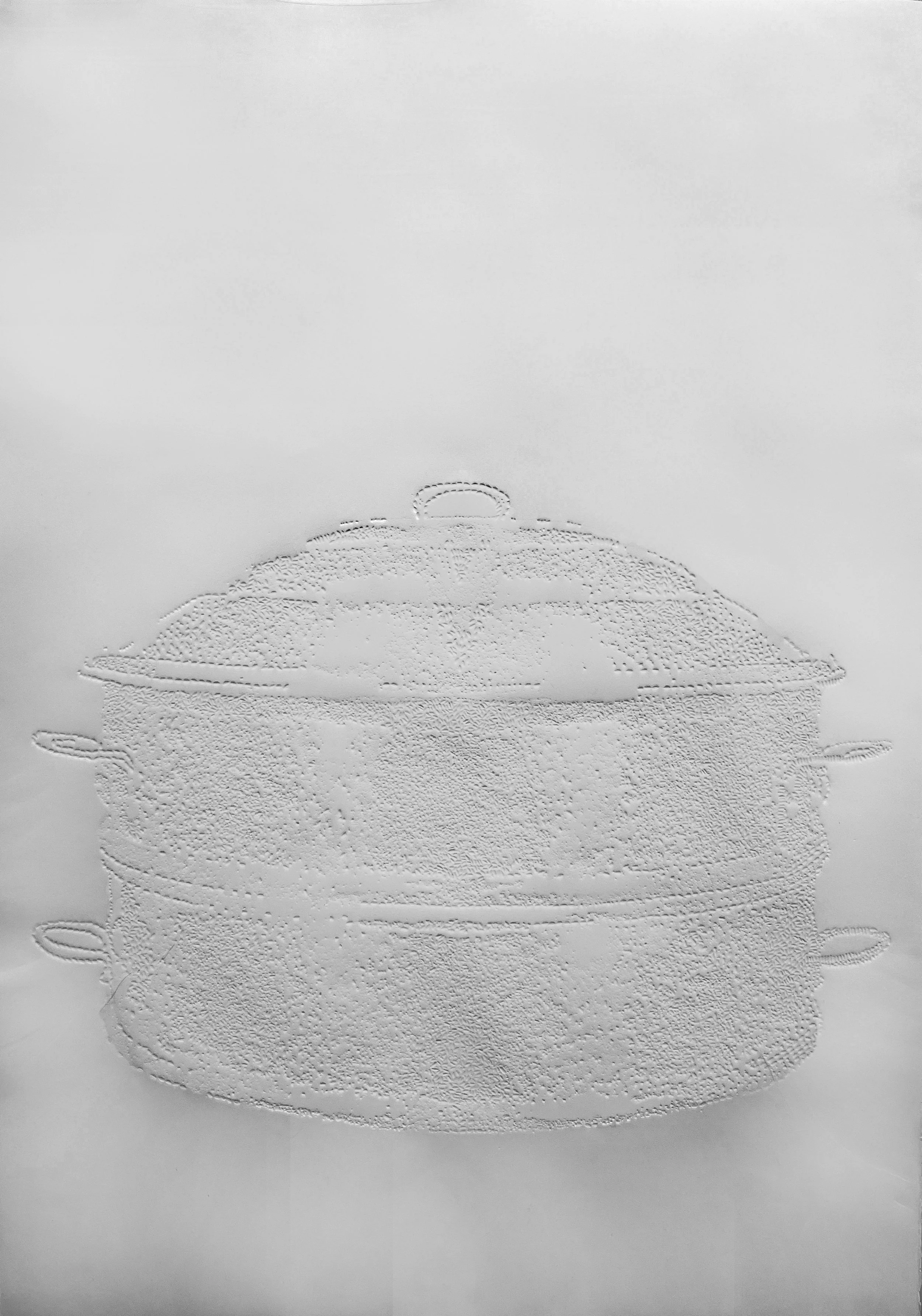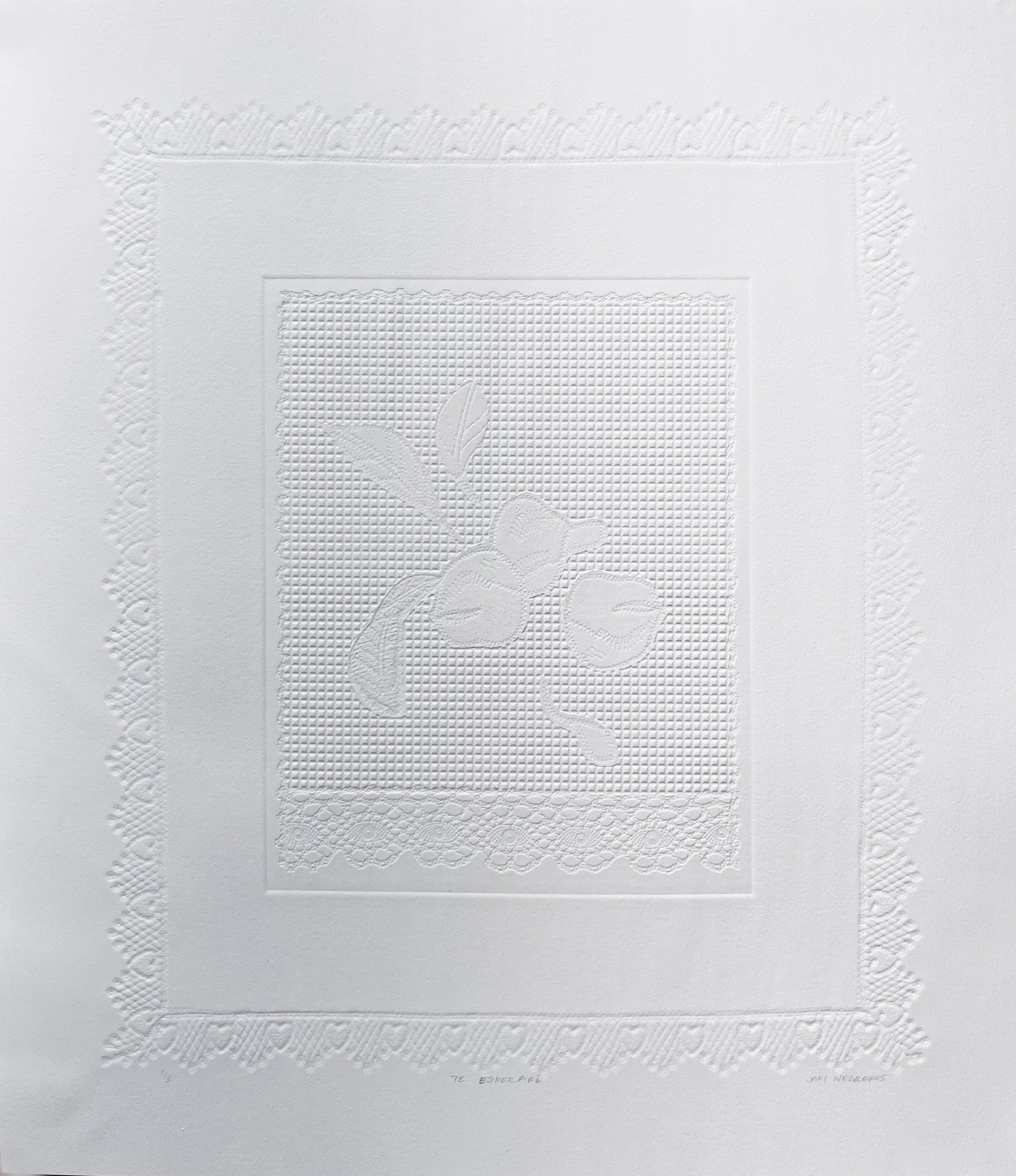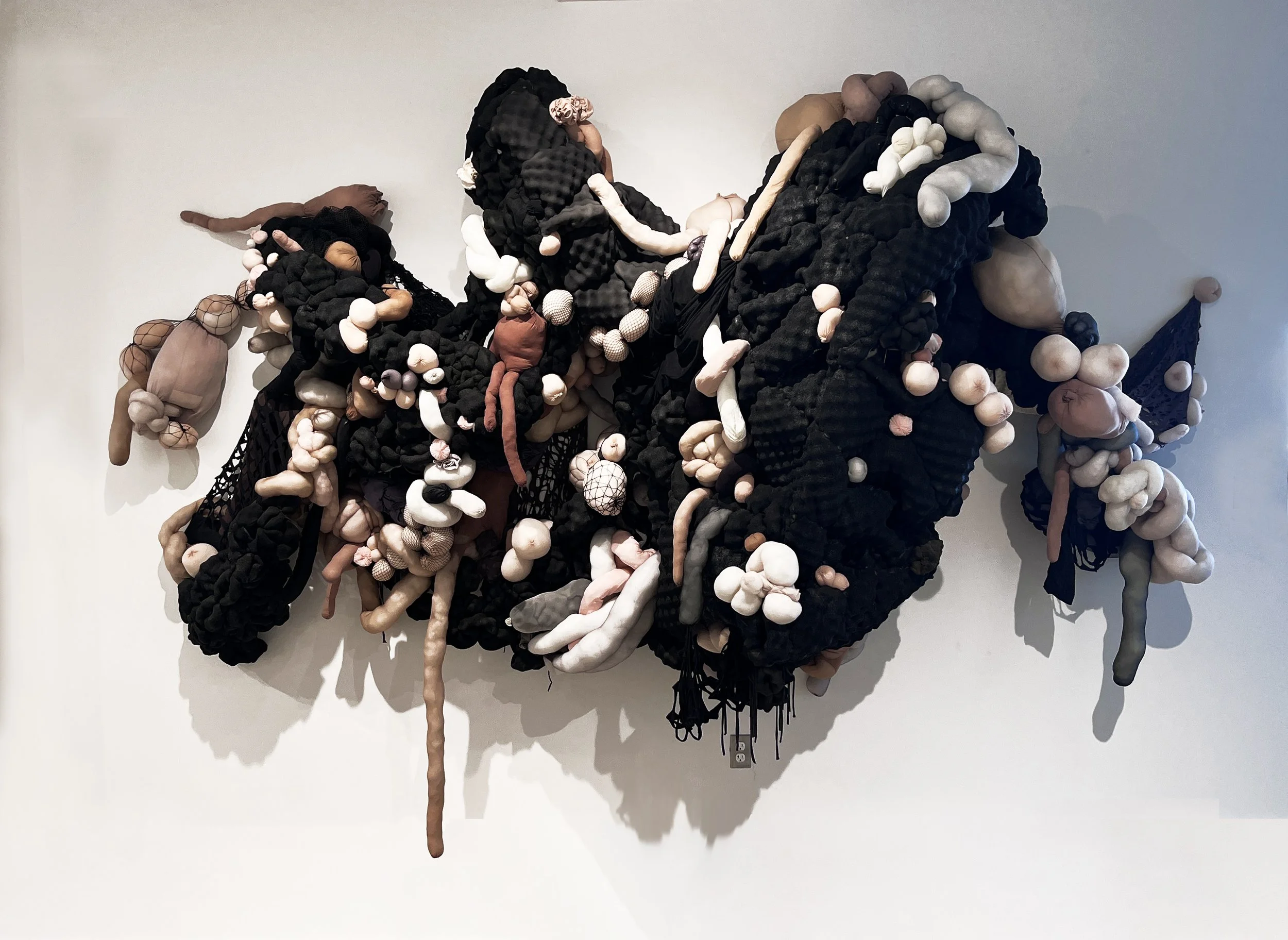Exhibition July 28 - Sept 17 | Artist Talk & Reception Aug 4
McKelvey Charitable Fund Gallery @ 204 S. Austin
Jacqueline Negreros’ solo show El Cariño Nunca Olvida (Love Never Forgets), will be hosted in RCA’s McKelvey Gallery featuring a collection of her colorful and unique prints. Drawing upon her parents’ experiences as immigrants to highlight themes of tradition, immigration, and assimilation conveyed through memories shared by the artist and her family, she uses food as a metaphorical device to probe cultural attitudes of authenticity and otherness through ingredients that remain traditional and those that have grown with her.
“I am interested in seeking wonder and curiosity within the seemingly mundane,” said Negreros. “The forms in my work are inspired by observations of my environment. Whether watching miso paste dissolve in boiling water, grains of rice puff, or taillights disappear into the distance, these personal vignettes instill within me the desire to suspend their form through creative practice. I am fascinated by texture found in natural and man-made objects. Textures that evoke stress are the ones I am captivated by and find the most endearing.”
The South Texas-based Negreros earned a Master of Fine Arts in Printmaking from Texas A&M University-Corpus Christi in 2022, and her Bachelor of Fine Arts in Studio Art from The University of Texas at Austin in 2013. She exhibits regionally and nationally and was awarded a scholarship in 2019 to study monoprint at the Glassell Studio School in Houston. She is an adjunct professor at Texas A&M University-Corpus Christi, where she teaches foundations, printmaking, and art appreciation.
“Jacqueline Negreros pushes the limits of material narrative, taking the commonplace and elevating it to Art,” said Rodriguez. “Her work is both personal and universal, recasting everyday objects as cultural icons.”
The Artwork
These works seek to convey pathways of memory and time. Made from rice embossed into white cotton rag paper with an etching press, the stark images depict tools critical to preparing barbacoa de chivo al vapor, the unsung heroes of our kitchen: la tamalera, a three-tiered pot my father uses to steam la barbacoa, el molcajete y tejolote my mother uses to prepare salsa, and el tronco de arbol on which the chivo is traditionally chopped into pieces for cooking barbacoa in the village.
I chose short-grain for embossing because of its roundness – each used like a pixel to form the full image. Preliminary photo references were processed using a bitmap to separate the values then they were printed to scale and laid on the press. I placed a grain of rice over the dark areas of the image and spaced them accordingly. This was not a mindless activity; I had to be present and pay attention to the position of my body.
If I moved carelessly or let out a puff of air, the rice would shift, and I would have to start again. This act became meditative and introspective. It became a space to reflect on my connections to family. How many grains of rice has my family collectively eaten?
How many memories do we collectively share?
Once the grains were arranged to fill the composition a damp sheet of cotton rag paper was carefully placed over. The paper is so large that a second person needed to help. Then the cushion felt was rolled over the paper and the pressure was adjusted to create tight contact between the rice, paper, blankets, press bed, and drum. As the handle cranked and the bed advanced, there was a loud crunch as the rice broke apart under the pressure. When the felt was peeled back it revealed paper stretched and molded around the grains in the shape of the source image. The sheet was then flipped over, and the grains were released from the indentations by running fingers over them. Each work is a monotype as there is only one impression that could be made from each matrix. The subtleties in each monotype are unique just like the iterations of each meal that I have eaten with my family.
These works require direct light to fully express the forms raised from the paper. The images disappear as one navigates the rest of the exhibition space. The ghostly impressions of the embossed rice signify these memories, La Olla for Dad, El Molcajete for Mom, El Tronco for la familia en Mexico.
In addition to cooking, I learned to embroider from my mother. She likes embroidered plants and animals from the natural world. I loved getting lost in the box of hilos and the way she broke the surface each time the needle poked through la tela, and yet it was always whole. We had a fat stack of servilletas adorned with bright colors used to keep the tortillas warm. These forms impressed into the paper reflect the textiles of my past. I utilize a combination of fabrics, plastic, and thread to create a textured printing plate. Through the process of blind embossing, this collection of ephemera is pressed into the paper to create raised or recessed relief images and designs in the paper by using an etching press.
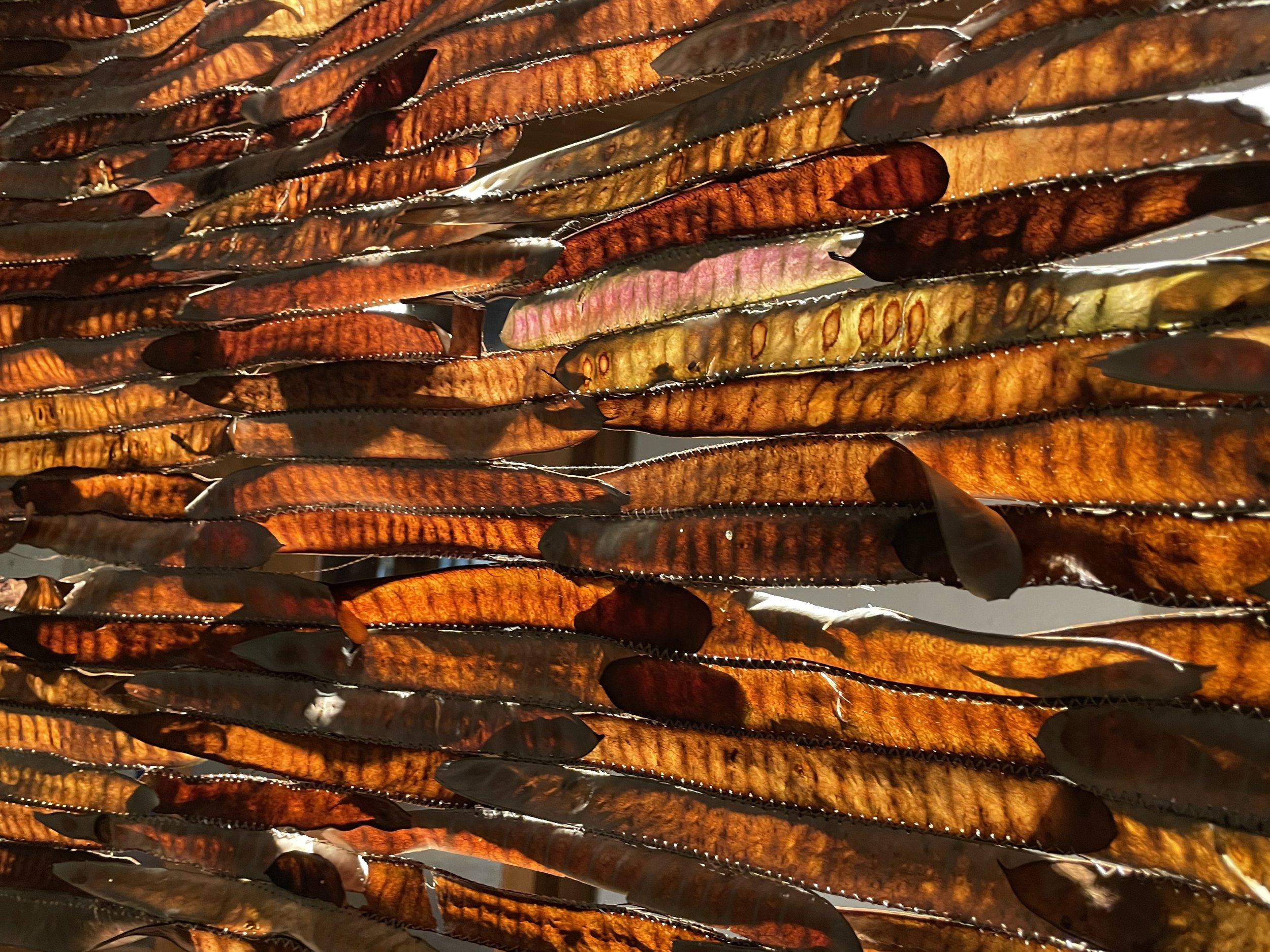
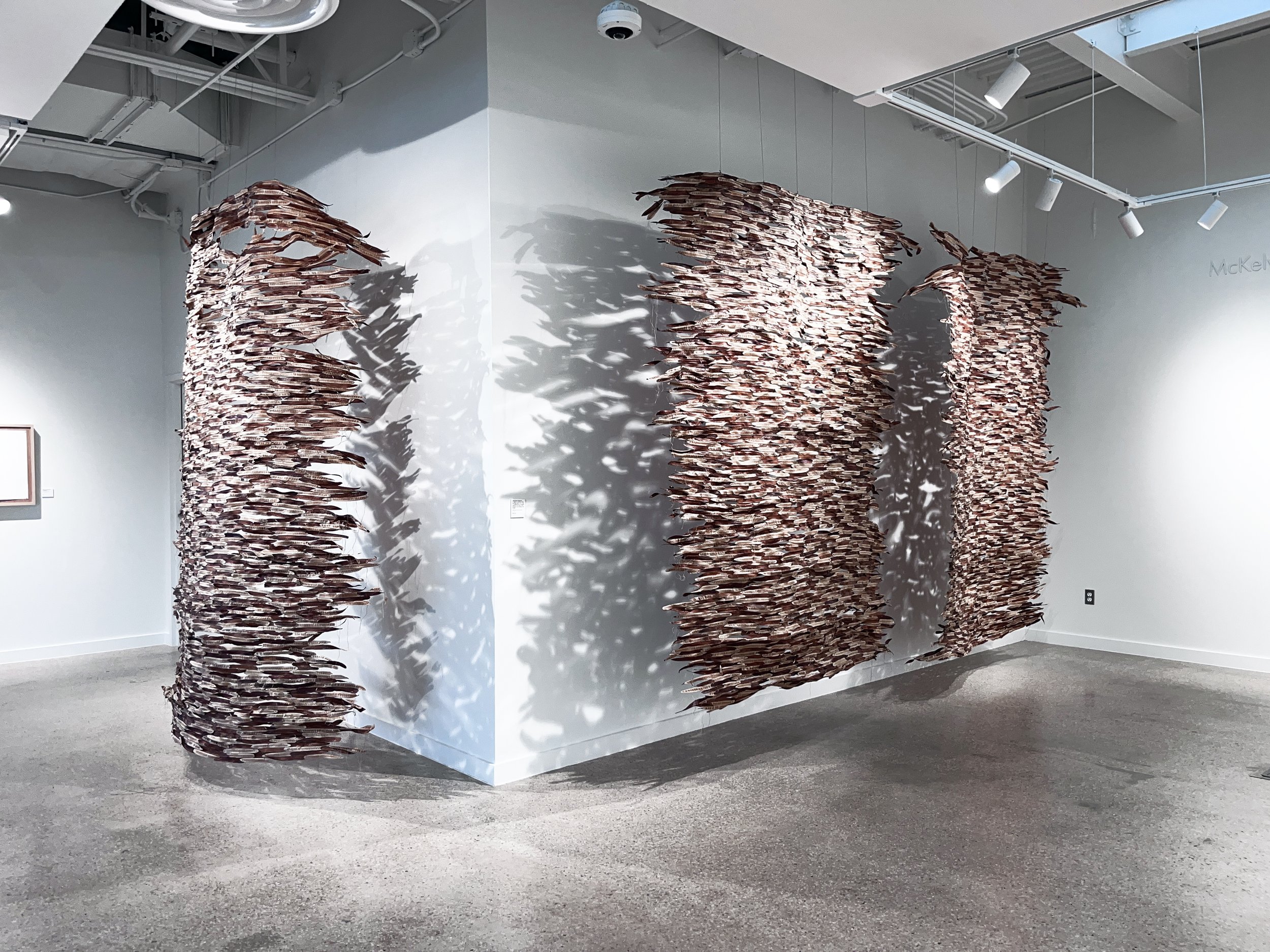
Lo que tú siembras bien en tierra fértil, tú lo vas a cosechar en un futuro is three, 8-foot hanging veils comprised of guaje seed pods sewn together with silk thread. I started this piece after gathering them in my neighborhood in Corpus Christi and near the Texas A&M University – Corpus Christi campus. Never in my wildest dreams did I believe I would encounter guajes growing wildly here. In Houston we either found them at the farmers market off Airline or my parents planted them. I only heard about these plants growing wildly along the river in Zacapala from their stories. But that is the beauty of finally looking with open eyes at the bounty that is before all of us. Once they were discovered, I saw them everywhere.
Using materials that are unseen, overlooked, or left behind is a creative extension of what I witnessed at home. My mom always finds a new purpose for everything. My connection to food waste is strange, particularly the leftover guaje seedpods. We only valued the nourishment from the seeds within, but the pods themselves hold so much possibility.
All these seed pods look the same at a glance but upon closer inspection they are each unique. I discovered they dried into a wide range of hues depending on the season – during the fall, a light brown color; the temperature drop in the winter imparted a deep tone, the color of wet earth.
The placement of the veils in the gallery acts as a border between the conscious and unconscious. One half shows the guaje as it appears outside – dry, muted. The illumination of light on the other half is like magic and reveals their complexity: the ellipsoid shape of the seed, the vein structure of the pod, and the seam that held them together.
The veils also represent my feelings dealing with otherness. Depending on who you ask, guajes are either a food crop, providing nourishment, or an invasive weed that reproduces exponentially. This threshold is a membrane for a fluid exchange between different states of identity.
La Pancita is a soft sculpture that signifies matriarchal bonds and the importance of ritual. My mother nurtured her connection to home by maintaining the preparation ritual for lapancita. I watched her prepare food everyday but the experience watching her handleoffal was otherworldly. It reflected a way of life in Zacapala that I only caught glimpses ofduring winter visits. I was fascinated with how she so lovingly cleaned the stomach liningand intestines, the delicate movement of her hands as she finely minced the herbs, dippingher clean hand into the pool of blood to break up the coágulos, unafraid.
Comprised of a wide range of cloth and foam materials, La Pancita was constructedaround a sturdy armature of aluminum strips and foam pipe insulation meant for plumbing.I thrifted most from clothing in the Goodwill clearance bins off Ayers Street in Corpus Christi; it was important they were similar in tone and texture to the lining of a stomach. I pulled hosiery from Value Village in Houston. The large mass of foam was gifted to me by my best childhood friend, Sarah Ta. The first set of t-shirts used to tie the foam were from my siblings and cousins. The decorative fabrics came from a box retailer.
The dark mass of La Pancita appears to sway and move, twisting and folding into itself. The shadows it casts stretch along the surface of the wall; a contradiction to the yielding forms that disappear into one another. Neutral colors grace the surface, bits of pink burst forth from the seams. Layers of fabric are suspended on top of one another; semi-sheer forms gasp for a pocket of air, tendrils dangle from pendulous forms, and stitched panels overlay to create countless ripples. Each bundle of material successively hugs one another, unable to resist any urge to be apart, they yield to maternal love.
El Carino Nunca Olvida presents a body of work inspired by my parents’ cooking as a symbol of adaptation, resilience, and affirmation. It weaves together a personal history to redefine multiple visualities of identity through food. No one taught my parents how to adapt their recipes; they dared to experiment to hold tightly to their sazón. The skills they honed would enable them to preserve flavors that nurture our roots.
These works manifest observations of my parent’s preparation of barbacoa de chivo al vapor in Houston, a memory of Chicago, and my recollections of Zacapala. The significanceof the dish is reflected in its ingredients but more importantly in the preparation of the meal and how it has evolved over time – adapting to new circumstances yet retaining its essence and authenticity. These works incorporate traditional art components and materials gathered to elevate and share food otherwise unseen or forgotten beyond the context of home.
I depend on my body’s ability to react to the work I am creating, assessing, and reassessing – very much like a chef sampling food during preparation to assess its qualities and to fine-tune recipes. One of the most important things I value in my work is the presence of the hand. I move between natural and artificial materials to create works that reflect living between two worlds, upon things that go unseen, to make the invisible visible, and the impressions we leave behind.
As the oldest daughter and first-generation American, I am choosing the role of illustrating and archiving our history through these different meals, true to the essence of what I know to be us. The works are created through a tactile sensibility of touch, response, and contemplativeness in relation to the foods that informs our familial identity and my individual sense of self.



